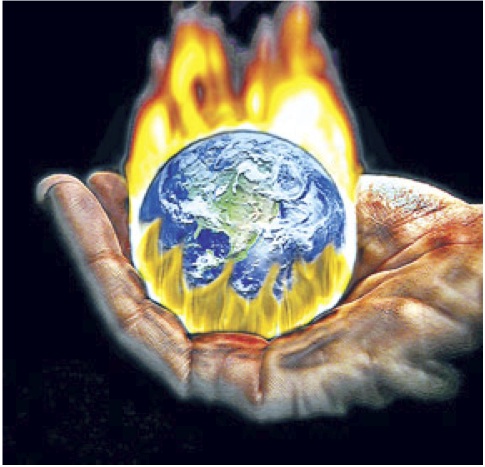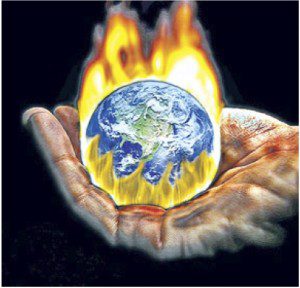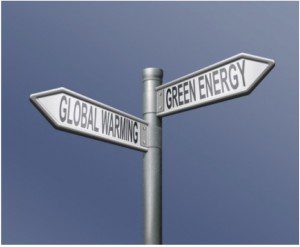
26 May EARTH MATTERS: 6 STEPS TO ADDRESS GLOBAL WARMING
 In spite of a La Niña climate pattern this past year, which typically lowers global temperatures, the National Oceanic and Atmospheric Climatic Data Center calculated that the national average temperature in the United States was the warmest year since that sort of record-keeping began back in 1895. As I presented in “Climate Change is Real,” (a previous article for this column), human-induced greenhouse gases emitted into the atmosphere over the last 150 years constitute the “smoking gun” explanation for the recent rapid change in the Earth’s climate. During the last few decades, scientists have worn rings in their laboratory carpets doing circles upon circles developing effective mitigation and adaptation strategies to address the problem. Consequently, it is well within our social, economic, and technological capacity to address the cause of global warming.
In spite of a La Niña climate pattern this past year, which typically lowers global temperatures, the National Oceanic and Atmospheric Climatic Data Center calculated that the national average temperature in the United States was the warmest year since that sort of record-keeping began back in 1895. As I presented in “Climate Change is Real,” (a previous article for this column), human-induced greenhouse gases emitted into the atmosphere over the last 150 years constitute the “smoking gun” explanation for the recent rapid change in the Earth’s climate. During the last few decades, scientists have worn rings in their laboratory carpets doing circles upon circles developing effective mitigation and adaptation strategies to address the problem. Consequently, it is well within our social, economic, and technological capacity to address the cause of global warming.
Nonetheless, ratifying an international agreement to address the problem has resulted in a political quagmire. Earlier valiant efforts such as the 1992 United Nations Framework Convention on Climate Change (UNFCCC) and the 1997 Kyoto Protocol have failed to significantly reduce global greenhouse gases. Part of the difficulty lies in the immense social and economic diversity of the participants in the planning process.
Barriers created by the differences in awareness and perceptions expose two complex underlying questions. The first involves the difficulty in determining the degree to which a person living in the present can be held responsible for the actions of others in the past and at what point could they have anticipated that the consequences of prior actions would cause the current global warming problem. The second question examines the difficult challenge of preventing a perception of “us versus them.” Where an “us versus them” perception prevails, history has shown that individual “tribes” justify actions that may be detrimental to others if they serve their own ends. Thus, overcoming the current political global warming gridlock will require an innovative strategy that dissolves the “tribes” and facilitates a truly international consensus to reduce human-induced greenhouse gases.
The overreaching goal of a global climate change strategy would be to encourage proactive mitigation, adaptation, and preventive actions designed to reduce climate change vulnerability, build resilience, and create opportunities for future generations. A strategic framework that could potentially facilitate an international consensus involves the following 6 steps.
Step 1: Foster Awareness of Issues Related to Global Warming at the Local Level
As local movements gain momentum and generate awareness they can foster a shift in public perception towards an understanding that addressing the cause of global warming requires a collaborative international effort. In turn, this realization assists in dissolving the “us versus them” barrier.
Step 2: Implement Local Climate Change Prevention, Mitigation, and Adaptation Plans
As the diversity of the participants in the planning process increases, so does the potential for political gridlock. Therefore, implementation of climate change prevention, mitigation, and adaptation plans have a higher rate of acceptance in local homogenous settings. In addition, place-based plans build community capacity and capitalize on local resources.
Step 3: Horizontal and Vertical Diffusion of Climate Change Planning
Communities that have benefited from implementing climate change planning can share information and resources with other communities thereby facilitating horizontal diffusion. As a significant portion of voters shift their perception and behavior towards taking action to address the cause and impacts global warming it will expedite vertical diffusion at the State and Federal levels.
Step 4: Redistribution of Political Interest in Congress
In order to end billions of dollars in subsidies given to the fossil fuel industry, voters need to elect politicians who want to shift away from fossil fuel use and support developing alternative renewable energy sources. The use of renewable energy sources would enable the US to comply with the emission standards outlined by the UNFCCC.
Step 5: Invest in the Future
According to the Lord Stein, the former chief of the World Bank, it would cost less then 1% of the world’s GNP to stabilize global carbon dioxide (CO2) emissions until the year 2050, whereas the cost of impacts caused by global warming would cost between 5% and 20% of the world’s GNP. Therefore, investing in the future will save billions of dollars and create new job opportunities. Sectors with the greatest potential include infrastructure, alternative energy, transportation, solid-waste management, water conservation, and land management.
Step 6: Develop a New International Strategy
A new international strategy needs to be developed that promotes equality between undeveloped and developed countries by allowing for policy changes as underdeveloped countries pursue increasing their standard of living. It also needs to include a mechanism for developed countries to mitigate excessive greenhouse gas emissions such as the European Union’s successful cap-and-trade system.



Sorry, the comment form is closed at this time.